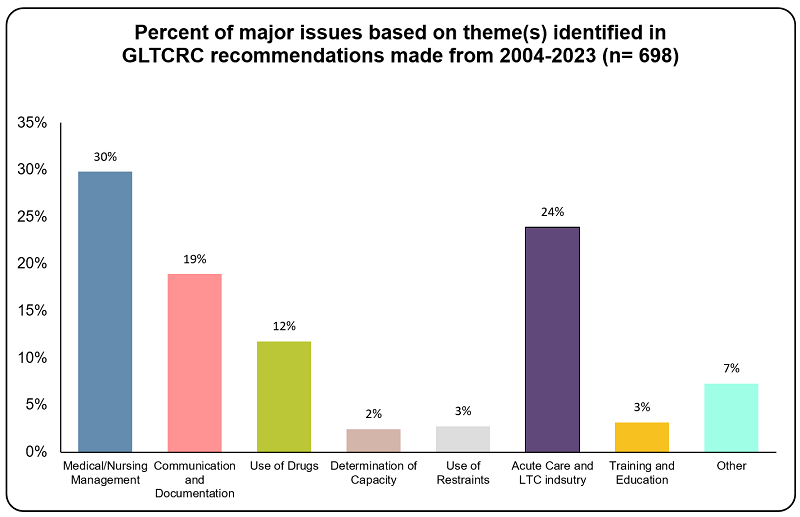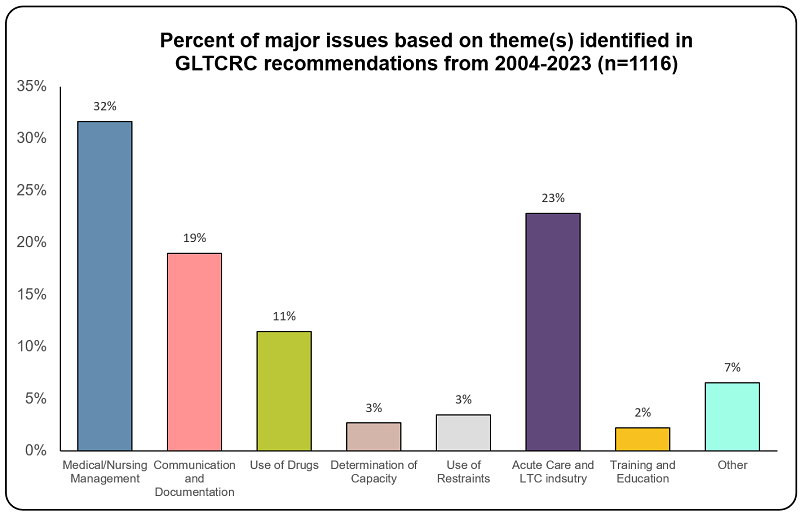Chapter 2: Statistical overview (2004–2023)
Between 2004 and 2023, the Geriatric and Long-Term Care Review Committee (GLTCRC) reviewed a total of 412 deaths and generated 1,007 recommendations aimed towards the prevention of further deaths. On average, the GLTCRC has reviewed 21 cases and generated approximately 50 recommendations per year.
It is recognized that there is an inherent bias as to which deaths undergo review (that is, most deaths are discretionary referrals sent to GLTCRC due to the presence of identified concerns and issues). There is also the possibility of researcher bias in attributing certain themes to cases and recommendations. It is recognized, however, that regardless of these potential biases, there are recurring themes that have emerged over the years. These themes can be applied at a broader level to cases and more specifically to focused recommendations.
The following statistical analysis of themes has been broken down into two distinct sections:
- An analysis of themes based on individual cases reviewed.
- An analysis of themes based on individual recommendations made.
By breaking the analysis down into cases and recommendations, it is possible to observe general trends relating to themes that emerge throughout deaths that have been referred and reviewed by the GLTCRC, compared to themes that have emerged from specific recommendations.
Trends based on themes in cases help to identify what issues are present in the deaths that are being referred to the GLTCRC for review. These finding help to identify if there is a trend in the types of cases that are being referred and reviewed.
Trends based on themes in recommendations help to identify what specific issues have been identified and addressed in recommendations aimed towards the prevention of further deaths. A trend in themes in recommendations helps to identify specific areas where the need for change, action, or attention has been suggested.
Graph One: Percent of major issues based on theme(s) identified in GLTCRC cases from 2004–2023 (n=698)
From 2004 until 2023, the GLTCRC has reviewed a total of 412 deaths. Many cases had more than one theme/issue attributed to the recommendations.
Note: ‘Other’ includes recommendations that do not fall into any of the other listed themes, including recommendations that relate to research, data collection, the referral to another committee, ministry, or legal/justice sector, or is case specific.
Graph One demonstrates that in 30% of the cases reviewed by the GLTCRC from 2004–2023, issues relating to medical/nursing management were identified. This is followed by 24% of the cases where issues pertaining to the acute and long-term care industry (including the Ministry of Health (MOH) and the Ministry of Long-Term Care (MLTC)) were noted and 19% of the cases where issues of communication/documentation were present. Other key themes included use of drugs in the elderly (12%), use of restraints (3%), training and education (3%), and determination of consent and capacity/DNR (2%) and other (7%).
Graph Two: Percent of major issues based on theme(s) identified in GLTCRC recommendations from 2004–2023 (n=1116)
From 2004 until 2023, the GLTCRC generated 1,007 recommendations aimed at the prevention of further deaths. Some recommendations had more than one theme/issue attributed.
Note: 'Other' includes recommendations includes recommendations that do not fall into any of the other listed themes, including recommendations that relate to research, data collection, the referral to another committee, ministry, or legal/justice sector, or case specific.
Graph Two demonstrates the percentage of common themes/issues attributed to the individual recommendations made from the cases reviewed from 2004–2023. Some complex recommendations may have been recorded as having more than one theme or issue. It was found that 32% of all recommendations made were related to medical or nursing management while 23% of the recommendations touched on the acute and long-term care industry, including the MOH and MLTC. The other themes/issues that were present, but that were less frequently assigned to the recommendations, were related to communication/documentation (19%), use of drugs in the elderly (11%), determination of capacity and consent for treatment or DNR (3%), the use of restraints (3%), training and education (3%), and other (7%).

